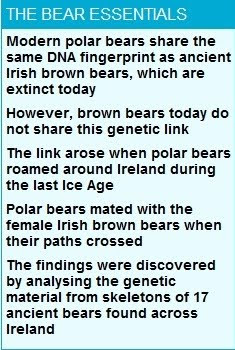 Surprising ancestry: Modern polar bears such as Walker, who lives at the Highland Wildlife Park in Kingussie, Scotland, are descended from Irish brown bears, according to a new study
Surprising ancestry: Modern polar bears such as Walker, who lives at the Highland Wildlife Park in Kingussie, Scotland, are descended from Irish brown bears, according to a new studyAcross the globe, there are hundreds of millions of people who lay claim to Irish ancestry, however tenuous the link.
Now it seems that polar bears can join the club.
A DNA study suggests that every polar bear alive today is descended from a single female brown bear living in Ireland during the last Ice Age, 10,000 to 110,000 years ago.
Although polar bears existed before that time, having evolved from a different group of brown bears in Siberia about 200,000 years ago, scientists say this Irish bear is their earliest known common ancestor.
The researchers studied samples of DNA taken from the bones and teeth of 242 brown bears and polar bears, including modern animals and fossilised bears that lived 120,000 years ago.
The analysis, published in the journal Current Biology, found that the mitochondrial DNA of living polar bears closely matches the genetic material taken from female brown bears living in Ireland 20,000 to 50,000 years ago.
As well as the different skin and coat colours, polar bears are larger than brown bears, and have a different tooth structure.
 How the world looked during the last Ice Age 100,000 years ago. Polar bears were able to mix with brown bears by travelling over ice to where Ireland is today (circled red)
How the world looked during the last Ice Age 100,000 years ago. Polar bears were able to mix with brown bears by travelling over ice to where Ireland is today (circled red) Polar bears live in the Arctic and are expert swimmers while brown bears are climbers that prefer mountain forests.
Polar bears live in the Arctic and are expert swimmers while brown bears are climbers that prefer mountain forests.Professor Mark Thomas, of University College London, who took part in the study, said: ‘Interbreeding between brown bears and polar bears is usually thought of as a dead end. But this shows it happened before and is part of the evolution of both species.’
He added: ‘The odd thing is that although polar bears and brown bears have been around for a long time, and are clearly different, these Irish brown bear genes have swept through polar bears so quickly.’
During the last Ice Age, polar bears roamed much further south than the Arctic.
At the time, Britain was connected to the rest of Europe by a land bridge, while ice sheets linked Britain with Ireland.
 A long way from home: The link between modern polar bears and now extinct Irish brown bears is thought to have originated from interbreeding when the bears' paths crossed as the Irish climate cooled
A long way from home: The link between modern polar bears and now extinct Irish brown bears is thought to have originated from interbreeding when the bears' paths crossed as the Irish climate cooledScientists say the findings could help protect the polar bear, an endangered species.
Dr Beth Shapiro, who led the study at Pennsylvania State University in the U.S., said: ‘We know that the two species have interbred opportunistically and probably on many occasions during the last 100,000 years.
‘Generally, this seems to happen when climate changes force the bears to move into each other’s habitats. When they come into contact, there seems to be little barrier to them mating.’
 Habitat: The area in green shows how far polar bears roam around the Arctic Circle today
Habitat: The area in green shows how far polar bears roam around the Arctic Circle todaysource:dailymail












0 comments:
Post a Comment
Note: Only a member of this blog may post a comment.